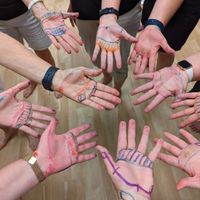That dreaded feeling: you're in yoga and your shoulder tweaks. You're running and your knee suddenly says, "oh, no thank you". You misjudge the distance between the curb and the street, effectively assassinating your ankle. In this busy world where we work, play, live and love, we have ample opportunity to injure ourselves. The overarching mentality is to just work through it. "I don't have time for this", or "it doesn't hurt that bad", are our mantras.
The unfortunate reality is that the more we ignore these maladies, the more likely we are to set ourselves up for additional problems down the line. These can look like recurrent injuries of the same variety such as rolling the same ankle over and over again because of pre-existing instability; "compensation injuries" that result from other anatomical structures trying to handle the load of the muscle, joint or bone that's not working at full capacity; or misalignments that result in the development of arthritis or chronic pain.
The good news is that if we approach these injuries from a place of self care and patience, they can heal more quickly and fully. The number one thing you can do is to pay attention to what your body is telling you and NOT ignore the pain. Our bodies have evolved whole systems to heal us with minimal work on our part. Since we don't want to be sidelined for days/weeks/ months at a time, here are five things you can do to help expedite healing.
1: Go to the doctor. Seriously. If the pain is bad enough that you're unable to properly move the area or bear weight, don't be a hero. The most important thing is to rule out a break, dislocation or soft tissue tear. Assuming that everything is intact and doesn't require serious medical intervention, you can continue self care with the following tips at home.
2: DO NOT apply ice. Ever. Recent research indicates that while ice does in fact reduce swelling by "shrinking" blood vessels to keep additional fluid from reaching the area, there are a host of other problems that arise from this (1). Oxygen, nutrients, and helpful cells that are necessary for the healing process can't get to the injury, and inflammatory chemicals that cause pain can't get out. What you can do to help reduce the swelling is to immediately and gently massage the area, as well as the areas above and below the injury. This will encourage the swelling to disperse, and will bring new blood to the area to speed healing. Continue massaging a few times a day until the swelling is reduced. If the skin is intact, topical applications like Biofreeze, Icy Hot, Tiger Balm, or a host of Chinese medicine liniments can help relieve pain.
3: Adjust your diet. Believe it or not, what you eat matters big time. Eating excessively spicy, cold or raw foods requires your body to expend additional energy to digest that food. That's energy that could be directed at healing your injury. Avoiding things like salads and sushi and focusing instead on cooked, nutrient-dense food such as bone broth, root vegetables and hearty soups can go a long way to helping an injury heal fully. Also, cut out processed sugar as it can trigger an additional inflammatory response in the body that should be avoided when healing (2).
4: Consider some kind of complementary medical treatment. Your primary care doctor and the hospital aren't the only options for healing. Massage therapy, chiropractic, and acupuncture all offer fantastic opportunities to give your body the attention it needs and speed up the healing process. They're also wonderfully effective at helping to relieve pain almost immediately.
5: Stay gently active but don't push it. Injuries need time to heal, so not over exerting them is imperative even if things "feel better". However, a light and gentle range of motion exercises - something as simple as wiggling fingers or toes - can be started almost immediately so that you recover normal function and continue to encourage blood flow. As the healing progresses, the exercises can become more comprehensive, but trying to do too much too soon will just cause additional injury and put you out of commission for even longer.
Injuries are an unfortunate reality of life. The best thing you can do if you sustain one is to be gentle with it and help your body heal itself. For further information, references and articles are listed below.
References:
(1) Tseng, C-Y, Lee, J-P, Tsai, Y-S, Lee, S-D, Kao, C-L, Liu, T-C, Lai, C-S, Harris, MB, and Kuo, C- H. (2013) Topical Cooling (Icing) Delays Recovery From Eccentric Exercise, Induced Muscle Damage. J Strength Cond Res 27(5): 1354-1361
(2) O'Connor, L, Imamura, F, Brage, S, Griffin, S, Wareham, N, Forouhi, N (2017) Intakes and sources of dietary sugars and their association with metabolic and inflammatory markers. Clinical Nutrition, Online June 2017













